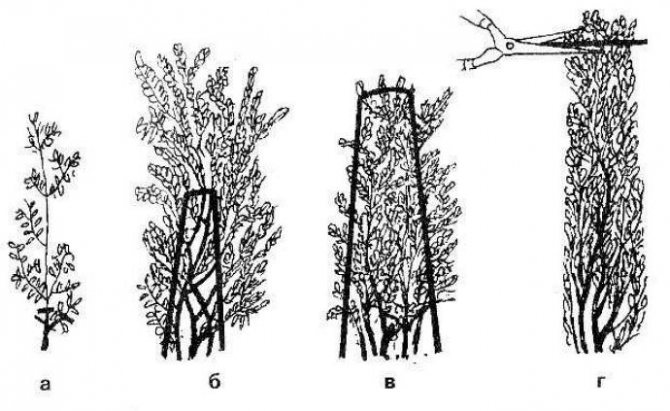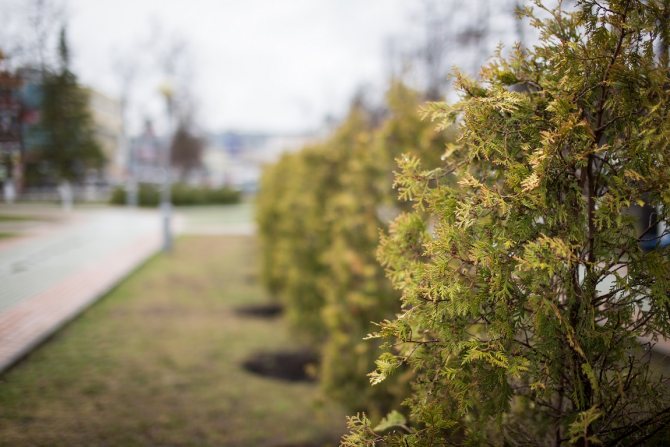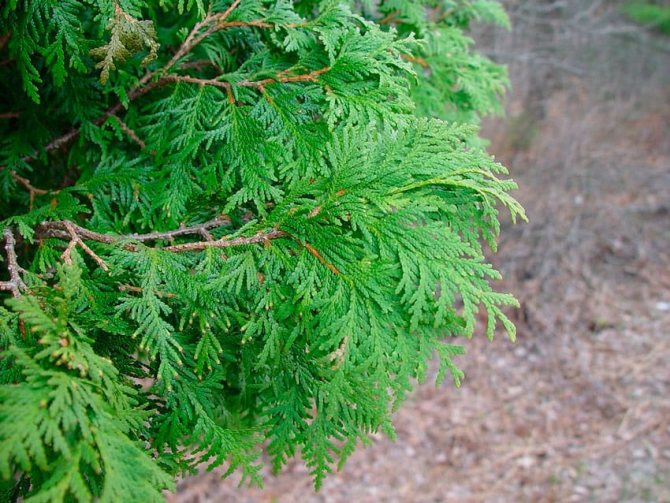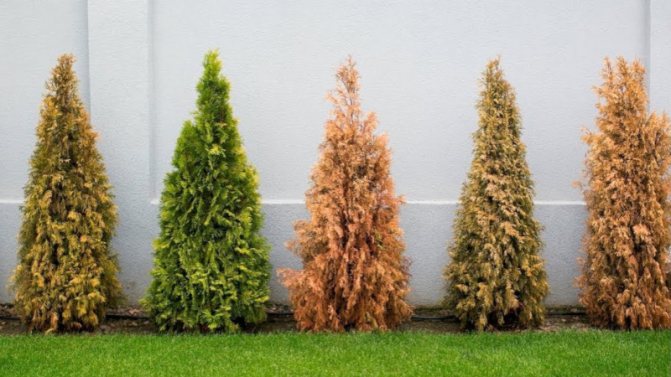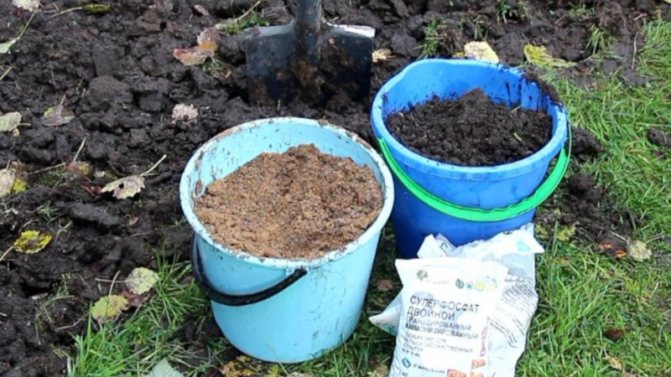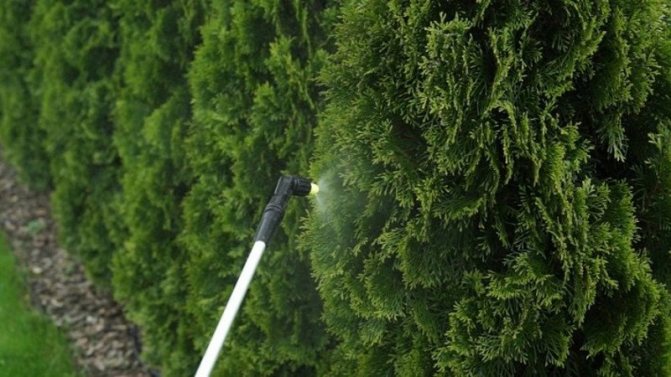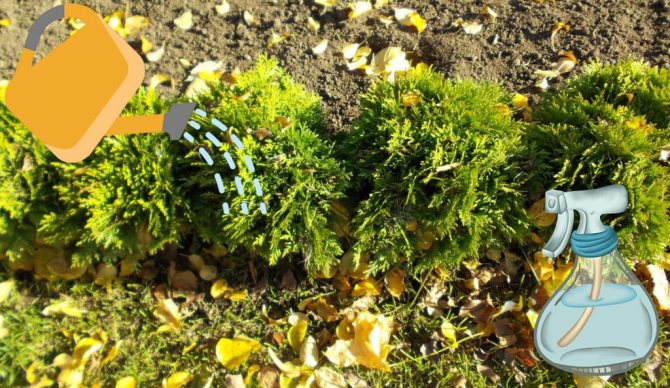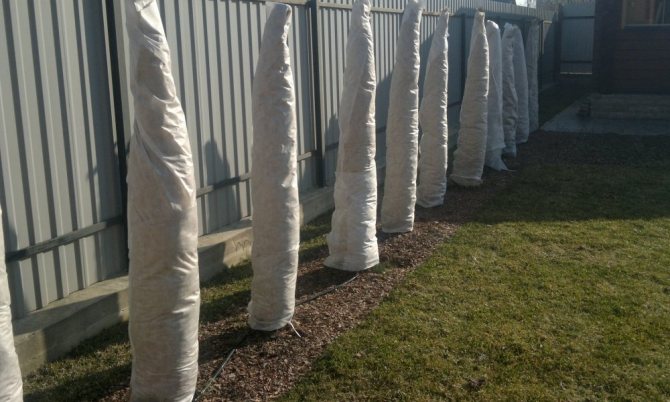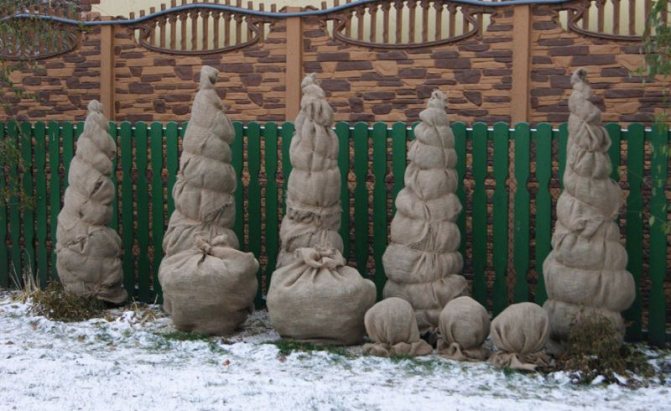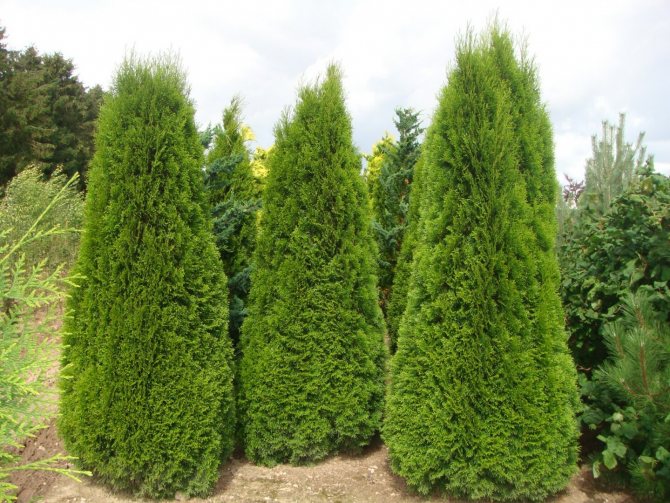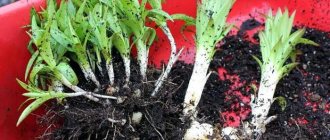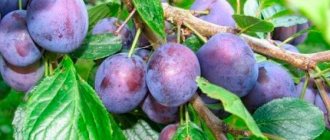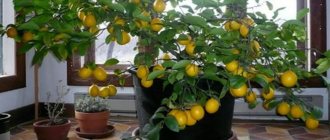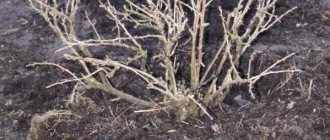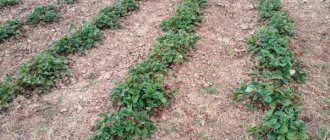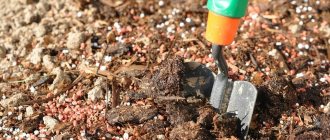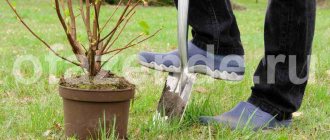The plant belongs to the cypress family. Since ancient times, it was believed that thuja is associated with funeral rituals. Translated from Latin, the word thuja means “sacrifice”. In fact, the branches contain essential oils, which, when burned, give off a specific aroma.
He was then of value to people who perform the rite of burial or sacrifice. There is nothing mystical about it. On the contrary, the plant is very beautiful and, with proper care, will serve as a decoration for the site.
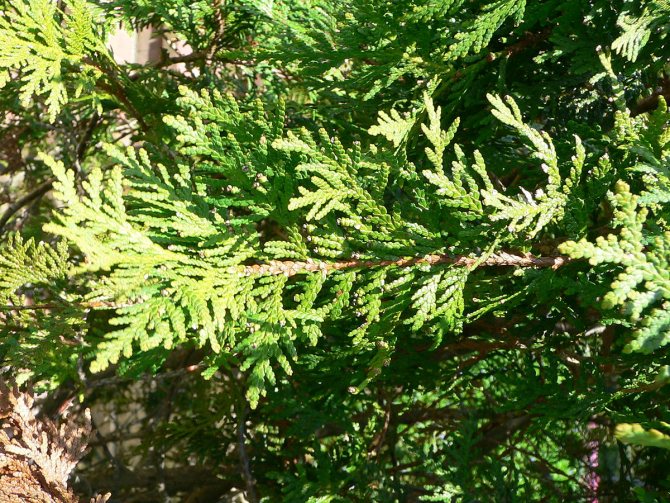
About 120 species are known, but not all can grow in the middle lane, and even more so in the north. Therefore, if you bring a plant you like from a trip, it may not take root in conditions of lower temperatures. And it's not about the quality of the soil: a small thuja gets used to a new place faster and takes root well.
The point is the change in temperatures. The root system of all types of thuja is superficial, so it freezes. Exotic species must be kept in a container on a covered veranda. In summer, take it outside, and with the onset of cold weather back to a warm place.
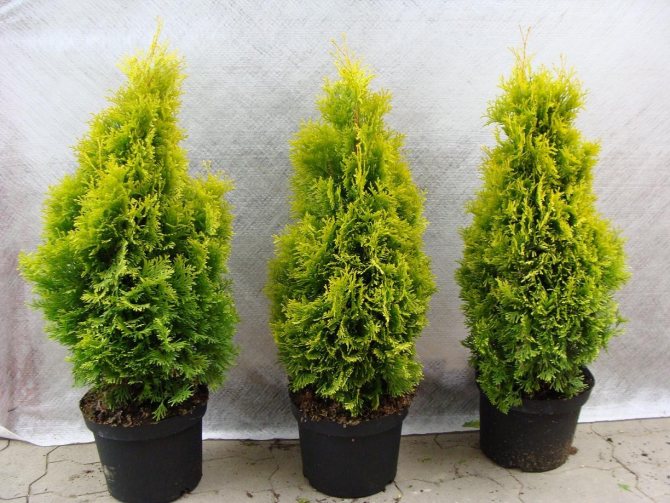

Plants in warm countries have constant access to nutrients. In winter, in the middle zone, it is more difficult to get food from the soil and the tree is deficient in minerals, so in the spring it develops worse and gives less growth. Thuja will have to be fed regularly, even in the fall. Therefore, it is best to choose a plant that can grow outdoors. This is the western thuja.
How to feed thuja if it turns yellow
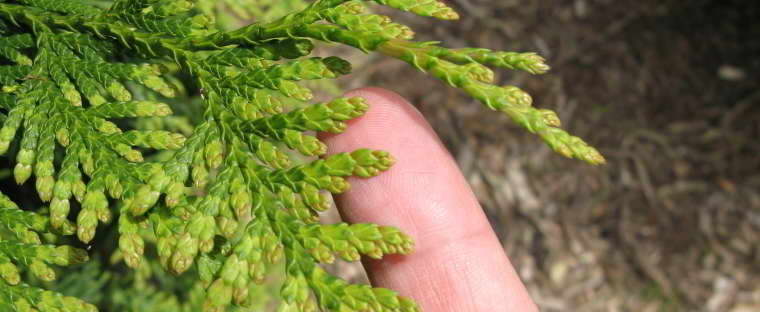

How to feed the needles turn yellow
Many do not know how to feed the yellowed thuja. Here you really need to first understand the cause of the phenomenon. Let's take a closer look at the most common problems:
- The needles brighten, acquiring a shade from light yellow to white: thuja is deficient in iron. Foliar treatment with iron chelate will help: make a 1% solution of the drug and spray the crown (emergency treatment). To prevent this phenomenon, treatments are done with a 0.5% iron chelate solution in early spring and early summer.
- With a lack of phosphorus, the tips of the shoots acquire a red-purple hue. Feeding with superphosphate will help: scatter 2 tablespoons of the drug per 1 square meter of the trunk circle and pour the thuja.
- Nitrogen deficiency is manifested by a significant reduction in the growth of young branches during the period of active growth, yellowing, discoloration of the needles is observed (signs of chlorosis). In this case, feed the thuja with ammonium nitrate: scatter 2 tablespoons of fertilizer per 1 square meter of the trunk circle and water the plants.
- If the crown top turns yellow, the plant lacks potassium and magnesium. Use potassium magnesium fertilizer: scatter 2 tablespoons of the drug per 1 square meter of the trunk circle and water.
Remember that an overabundance of any element is much worse than a lack of it. Over-saturation of the soil with nitrogen can cause significant harm (if you overdid it with nitrogen, apply potassium-phosphorus fertilizers to neutralize the negative effect of nitrogen). Nitrogen fertilization activates the growth of shoots, which is very good in spring. In the summer, it is no longer possible to add nitrogen, since young shoots will not have time to ripen and will freeze in winter.
Types of the most common mistakes
Inexperienced gardeners who have never encountered the cultivation of a crop immediately make a lot of mistakes. As a result, the tree cannot stand them and over time either dries up or decays. Here are the options for the most common mistakes from agricultural practice:
- for the winter, the crowns of young trees are left uncovered;
- use fertilizers that are intended for deciduous trees (nitrogen complexes);
- do not cover the needles with sun screens;
- take cover too early.
An important step in the development of a tree is crown formation. If it is incorrectly laid, then the plant immediately loses its appearance. Therefore, after the shelter is removed, the thuja must be cut off. For pruning, take a pruner, it is convenient for them to work. First of all, remove dry and diseased branches with yellow needles from the top and middle of the tree, they are already dead. If the crown is too thick, discharge it a little. This will increase the breathability of the tree and also reduce the risk of pests attacking the crop. So that your thuja grows better not upward, but in width, cut off part of the top, trimming the top helps to stimulate the lateral shoots, they are activated. There are 3 types of thuja pruning:
- spiral. The most common form for cutting thuja. in general, the tree resembles a large cone, its top will be narrowed;
- spherical. The option is suitable for the formation of low crowns. The plant looks great in the summer cottage, in the winter garden;
- topiary. The crown is formed in the form of any geometric shape: rhombus, square, ball. In garden stores, metal frame forms are sold for laying the crown, according to which they are subsequently pruned.
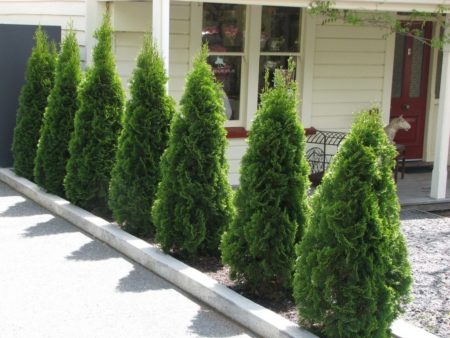

Thuja will be the main decoration of your local area, if you take care of it correctly: cover it from the cold outside, trim the crown, water regularly. A healthy and beautiful tree is pleasing to the eye and attracts the attention of everyone around. Thuja can live for tens of years, no matter in which region you planted it, so if you love evergreens, then the choice for planting is obvious.
Each plant is a living organism that requires an individual approach to the choice of activities aimed at caring for it. You need to devote a minimum amount of time to some plants, they are unpretentious and do not require large expenses from you.
And there are plants that are not so easy to grow. For example, caring for thuja in winter consists of a set of activities that it is advisable to carry out in full in order to keep the plant healthy and beautiful.
It is this issue that we will pay attention to in this article, because thuja is one of the most popular species that many gardeners prefer to use in landscape design.
Do I need to feed thuja and junipers if they do not turn yellow
For successful rooting and adaptation in a new place of growth, thuja seedlings are fed immediately upon planting. Also, during the first few years, you will need to regularly apply organic or mineral fertilizers to help form a healthy skeleton and a lush crown.
Coniferous shrubs and trees will be able to extract all the necessary substances for normal growth from the soil on their own in adulthood. But even then, you should periodically feed it so that the evergreen beauties do not suffer from the natural depletion of the soil.
Let's talk more about the fertilization schedule. Timeliness, dosage and the correct method of feeding are important conditions.
Is it possible to keep the thuja in the apartment. Room thuja care
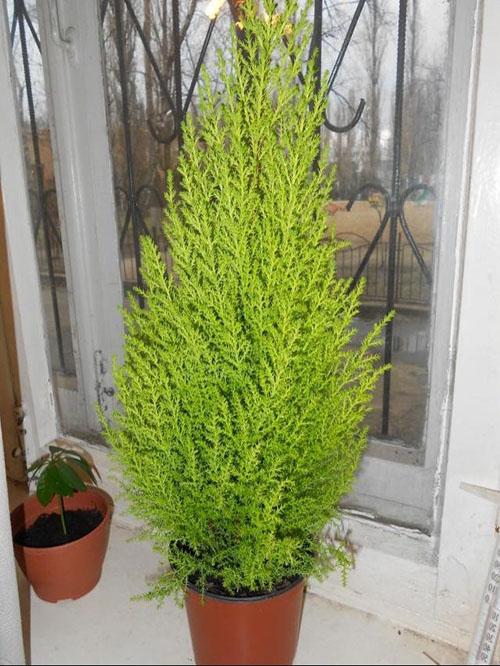

Thuja is one of the unpretentious plants. But despite this, before caring for a room thuja, you should know some subtleties.
Lighting. Thuya in the apartment does not like too bright light. With this in mind, keep the plant near the northern windows.In winter and spring, it is necessary to shade the flowerpot from direct sunlight.


Temperature. In summer, a comfortable temperature is considered to be 20 - 30 degrees. During this period, thuja is useful to grow in the air. Find a shady, draft-free area for her. As for winter, these thermometer indicators for a tree are too high. Make sure that the temperature does not rise above + 15 ° C. Thuja is frost-resistant, but it is better not to expose indoor specimens to the cold test.
For planting thuja, you can use a pots.
Humidity. This plant reacts normally to dry indoor air. The heat does not frighten her either. But high temperature and low humidity are not the best combination. Periodically, you still need to spray the plant with a spray bottle.
It is not recommended to grow thuja in plastic, ceramic or metal pots. These materials will not be able to protect the roots of the plant from the cold. They also crack easily.
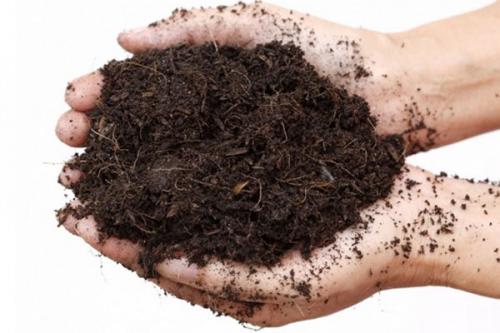

The soil. At home, thuja grows well in a pot. You just need to choose the right soil. The best soil for thuja is a mixture with a slightly acidic reaction. You can prepare the ground yourself. For a young plant: take coniferous (2 parts) and leafy soil (4 parts) + sand (1 part). An adult thuja will feel comfortable in such a mixture: prepare turf soil (1 part) + peat (1 part) + sand (1/2 part). The ready-made store substrate has almost identical composition.
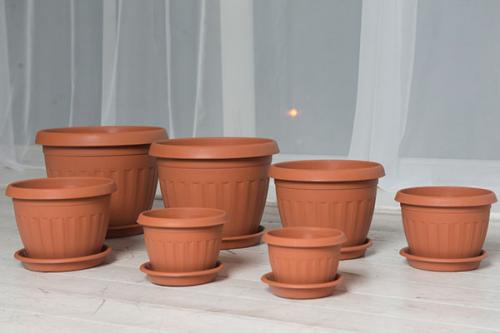

Pot. For thuja that grows indoors, the pot can be anything. The only condition is that the capacity should be taken deeper than the root system itself. This will help the thuja grow properly. It is also worth taking care of the drainage holes in the bottom of the pot. Stagnant moisture is detrimental to this plant. If your thuja will be on the balcony or veranda, the pot will have to be selected more carefully. It is best to buy a container that is made of frost-resistant material.
How to feed thuja when planting
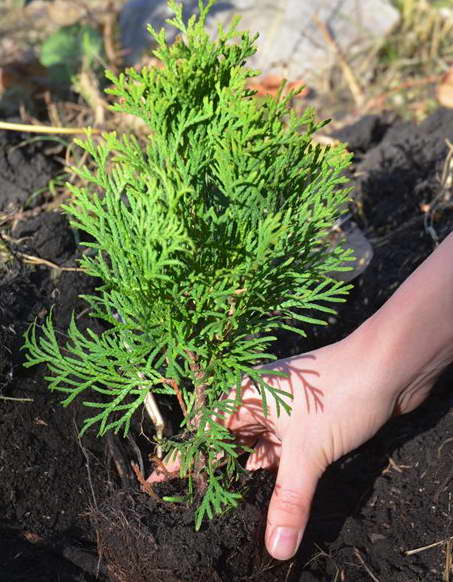

How to feed thuja when planting in autumn and spring
The first feeding when planting seedlings is fundamental. If you prepare the planting pit properly (do not skimp on nutrients), additional feeding will not be needed during the first year of growth. Also, do not forget that a young thuja will tolerate a lack of nutrients better than an excess.
So, for the most important first feeding, we need dry organic matter: humus or compost and wood ash. With a planting pit diameter and depth of 1 meter, the nutrient base should consist of 2 compost / humus buckets and 3 kg of wood ash. We distribute the wood ash evenly along the bottom, and mix the humus with the ground and use it for backfill.
Top dressing should be applied carefully so that the plant does not freeze
Before fertilizing thuja in the fall, read the important recommendations:
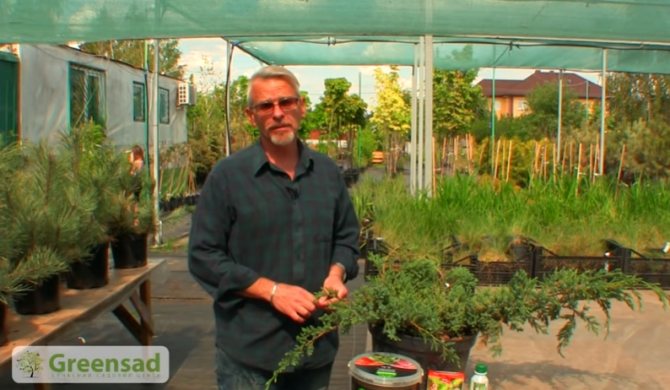

The gardening expert recommends, if possible, not to feed the plants at all in the autumn, so as not to cause the formation of young shoots, which die in winter.
- If you are fertilizing to improve growth when planting in the fall, do so no later than early September. Otherwise, the growth process will not stop until winter and frost will severely damage the plant.
- Try to use organic fertilizers... They provide the plant with everything necessary and at the same time do not cause increased growth and the formation of new shoots.
- When using mineral formulations, strictly follow the recommendations on the packaging... Any violation of technology can do harm, not benefit thuya.
- Be sure to water the tree the day before feeding.... Nutrients pass through moist soil much more easily and the effect is increased.
Video:
How to feed thuja for spring growth
Next spring, thuja needs a comprehensive diet: nitrogen, calcium, phosphorus, potassium, magnesium, iron, etc.
Spring feeding should become a permanent element of care, regardless of the age of the plant.Depending on the climatic conditions of your region, spring feeding is carried out from the beginning to the end of March (the soil should already thaw).
What mineral fertilizers to use
For spring feeding, ammonium nitrate, superphosphates, potassium-magnesium mixtures, calcium preparations and complex fertilizers with a prolonged effect are used. Bone meal has proven itself as a source of calcium - organic matter works great and does not cause harm.
If wintering for young thujas was difficult (they suffered from sun and wind burns, received frostbite), additionally use drugs that stimulate root formation. It could be Agricole, Kornevin.
Can thuja be fed with urea?
Urea is a more aggressive top dressing, its nitrogen content is much higher, plus the decomposition period is longer. For thuja, urea (carbamide) is an undesirable fertilizer; it is much better to use ammonium nitrate.
How to carry out autumn feeding of thuja
Autumn feeding of thuja should be carried out correctly, and it has many features. Very often, after feeding, the thuja feels bad, becomes even more weakened. Something went wrong. Young plants do not require feeding at all, and adult thuja do not require special fertilizers if they grow on fertile soil. If it is planted in a container, and not in open ground, you need to apply complex fertilizers every 2 weeks, regardless of the season.
For those who doubt whether feeding the plant will harm, we can recommend the only type of safe feeding - bedding. For this manipulation, use one of the following materials:
- compost;
- bone meal;
- wood ash;
- peat.
The bedding around the tree allows the soil to be enriched. Such feeding is well accepted by thuami, preventing young shoots from growing intensively. If the soil has been enriched in the spring, mature trees do not need to be additionally fed.
How to feed thuja in summer and autumn
We lay the foundation of autumn and winter nutrition in the summer. Only in the southern regions, where the climate is mild and the onset of cold weather is late, the procedure can be extended until the end of September or the beginning of October.
Summer feeding with vermicompost and preparations that provide not only saturation with useful elements, but also resistance to fungal diseases will be an excellent supplement to the diet. These are Fitosporin-K, Fitosporin-M (the letter index indicates the content of potassium or magnesium).
The working solution of phytosporin is prepared depending on the form of fertilizer:
- Pasta - dilute 3 teaspoons in 10 liters of water;
- Powder - take 5 g of the preparation for 10 liters of water.
Coniferous plants can be treated with such a solution in spring and summer. Spray on the crown twice a season with a frequency of 14 days in dry weather; in rainy weather, reduce the interval to 7 days. They also watered at the root a couple of times, waiting 1 month between dressings.
In the summer, when the heat is intense, sprinkling with plain water is especially important, which should be carried out in the evening. This will help freshen the plants, protect against overheating and burns. When Epin or Zircon is added to the water, an effective anti-stress feeding will be obtained.
Spring feeding
After planting, the next fertilizer is applied in a year. In early spring, mineral preparations are used. Depending on the climate, they need to be applied from the beginning to the end of March.
Superphosphate
Starting from 1 year old, thuyam is given a superphosphate powder. The name of the drug is justified, since it contains more than 20% phosphorus. The composition also contains calcium, sulfur and magnesium. The powder is scattered under the trees, embedding 4-5 cm deep into the soil.
Superphosphate has undeniable advantages - it is suitable for any soil, is quickly absorbed, and prevents some diseases.The powder helps the root system to form. So that it does not lose its beneficial properties, it is mixed with other drugs according to the instructions. In a solution with ammonium nitrate, lime, urea, gypsum, it is neutralized.
If thuja grows on acidic soil, lime or ash is added a month before superphosphate is added. They deoxidize the soil, and the drug is more easily absorbed. Experienced gardeners add potassium salt, boron and zinc to superphosphate. 2 g of the drug requires 1 g of salt, 10 mg of boric acid, 20 mg of zinc sulfate.
When for phosphorus deficiency, double superphosphate is usedcontaining up to 46% of a trace element. In addition to phosphorus, it contains aluminum and iron.
Ammonium nitrate
The drug contains more than 30% nitrogen, 14% sulfur. The latter improves the absorption of nitrogen by the root system. In the spring, a site is fertilized with a solution of ammonium nitrate. For him, take 30 g of powder and 10 liters of water. This amount is enough for 1-2 plants. If the thuja grows on acidic soil, calcium carbonate is added to the nitrate.
Bone flour
Bone meal is used for many plants, as it contains many trace elements. It is made from the bones of animals, fish, which are crushed to a powdery state. The substance is useful for thuja and soil. Phosphorus, which is slowly released, saturates the plants for several more years.
The powder contains the following components:
- nitrogen;
- phosphorus;
- copper;
- cobalt;
- iron;
- manganese;
- iodine.
Due to the high percentage of nitrogen and phosphorus, bone meal is called phosphoazotine.
The drug can be purchased in various variations - standard (up to 15% phosphorus), steamed (up to 25%), fat-free (up to 35%). Flour is used dry, scattering over the area or for digging. A handful of powder (100-150 g) is poured under each tree, since it is sufficiently concentrated. Bone meal can be used for planting - 100 g in each well. The reserves after such fertilization are sufficient for development throughout the season.
Dry application is effective only on loose soil.
Bone meal solution is suitable for heavy soil that does not allow air to pass through. It is prepared from 1 kg of dry matter and 20 liters of water. Before this, the liquid is heated, but not boiled. The tool is insisted for 10 days, after which it is ready for application. Bone meal is popular with gardeners because it is budgetary, contains all the necessary minerals, and does not harm the environment.
Root formation stimulant
Thuja responds well to growth stimulants. They are needed when the roots are frozen or the branches are sunburned. Preparations allow the plant to recover faster.
Kornevin
The drug belongs to the group of phytohormones - agents that stimulate root formation, increase the defenses of plants. Kornevin contains indolylbutyric acid. Once in the soil, it turns into a hormone that stimulates growth. When in contact with the trunk, it irritates the tissues, causing the formation of callus. Callus is an area with new cells that cover plant wounds.
Kornevin is an addition to standard fertilizers. It does not replace organic and mineral products.
Before use, put on a mask and gloves, prepare a separate container for the solution. 5 g of the drug is diluted in 5 liters of water. The seedlings are immediately watered with liquid: the first time when planting, the second - after 14 days. One plant requires 2-2.5 liters of solution.
The tool is also applied dry - the roots of the seedlings are powdered with powder. Since Kornevin is concentrated, it is mixed with an equal amount of crushed activated carbon. To protect against fungi, a fungicide is added to the powder in a ratio of 10: 1. The drug protects thuja from drought, overflow, temperature changes.
Agricola
Agricola is a mineral preparation for root and foliar feeding. It contains nitrogen, potassium, phosphorus, zinc, molybdenum, copper, manganese. Especially for conifers, humic acids are added to it.It can be purchased in the form of granules and concentrated solution. The wet method is often used: 25 ml is dissolved in 10 liters of water. The product is poured while stirring the liquid in the container. Depending on the height of the thuja, 3-5 liters are needed per tree. The next portion is added after 2 weeks.
When spraying the leaves, trace elements are absorbed faster.
Agricola's advantages include the absence of heavy metals, chlorine, high efficiency, and economy. The product strengthens the sheets, promotes good growth, and increases resistance to adverse influences. Iron, magnesium and sulfur give the branches a deep green color. It is irreplaceable on dry, salty soils. Agricola is used throughout the growing season - from spring to autumn.
All young plants require nitrogen fertilization. The seedlings have an insufficiently developed root system, so they do not extract the necessary trace elements from the soil. When they grow, top dressing is carried out to maintain the composition of the soil.
How to feed thuja before winter
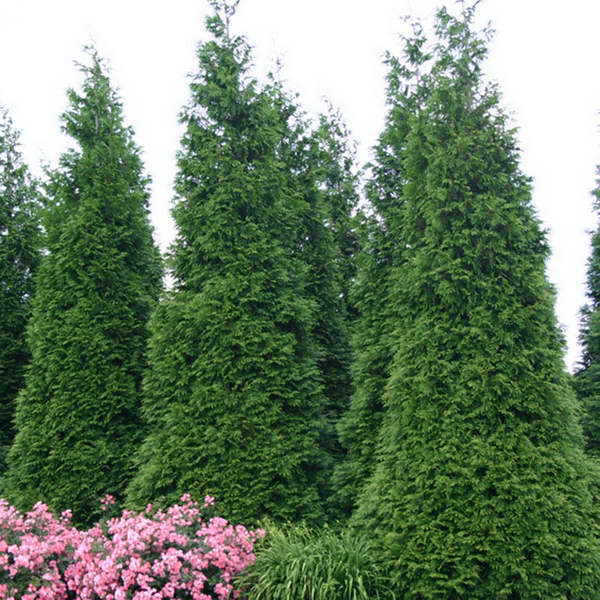

How to feed thuja before winter in September
Potassium is an essential element for successful wintering. To prepare thuja for winter, feed them before winter (in August or September, depending on the region) with potassium monophosphate: dilute 10-15 grams of the drug (2-3 teaspoons) in 10 liters of water and pour 1 plant.
After feeding, mulch with a thick layer of any organic matter. Use humus, compost, straw, or hay.
Mycorrhizal preparations for thuja
Mycorrhizal vaccines can be used in addition to fertilizers. The preparations contain mycorrhizal fungi, which have the following effect on plants:
- increase the absorbency of the root system;
- improve water supply;
- reduce sensitivity to environmental stress;
- increase resistance to fusarium, late blight and other diseases;
- stimulate root growth;
- increase the availability of nutrients.
With proper feeding of thuja, competent care, the plant will delight with a beautiful appearance, green needles.
Methods for correct fertilization
To achieve the maximum effect, you need to know not only how to feed the thuja, but also how.
Follow some simple rules:
- The frequency between fertilization should be about two weeks;
- In conditions of a more harmful strip of Russia and to the north, fertilization should be stopped with the onset of autumn (in the south, you can feed it until early October);
- Liquid top dressing should not be applied on dry soil. A day before feeding, spill the trunk circle with plain water;
- You should not use several complex drugs at the same time: an excess or shortage of any element may occur.
There are two main ways to feed thuja:
Fertilizing at the root
Root feeding is done with liquid nutrient solutions and dry fertilizers. As the latter, compost, humus and bone meal are most often used - they best affect the growth of thuja. They are distributed in the near-trunk circle in an even layer 3-5 cm thick and carefully dug up with the top layer of soil, trying not to harm the root system.
It is beneficial in spring to feed the thuja with granular universal fertilizer with a prolonged effect. At the beginning of the season and throughout the growing season, they will nourish the soil with the necessary elements, contributing to intensive growth and development of a beautiful lush crown.
Let's get acquainted with a specific effective preparation: "Fertika coniferous for evergreens - spring". Top dressing contains water-soluble calcium. Fertilizer granules can be applied to the planting pit, using about 30-40 grams per plant. During the period of active growth, feed a couple of times during the period May-August (it all depends on the fertility of the soil and climatic conditions, you can do with one top dressing). Consumption is 60 g per 1 m².
When distributing granules, step back 15 cm from the trunk and do not go to the crown diameter. When feeding adult plants, it is permissible to go beyond the projection area of the crown.
When using water-soluble preparations (liquid biohumus, superphosphate, ammonium nitrate), follow the instructions for preparation.
Foliar dressing
Thanks to its scaly needles, thuja is able to absorb nutrients through the crown. Foliar processing begins from late April to early May.
As mentioned earlier, solutions of Zircon and Epin preparations are used. Do not overdo it, irrigate at intervals of about 2 weeks, three treatments are enough per season. In severe drought, spray with regular water in the evenings.
There are other complex preparations on the market that contribute to successful growth and reduce the negative effects of a hot environment.
As you can see, even when grown on infertile depleted soils, the situation can be corrected by regular fertilization. Timely and competently fill the lack of nutrients, then your thuja will be luxurious, with a lush crown of a rich shade.
Seasonal fertilizers for conifers
Fertilizers for thuja need to be applied according to the principle "it is better not to feed". The fact is that with large doses of minerals, the tree begins to grow vigorously, but at the same time it loses its decorative characteristics: there is less greenery, naked long shoots are visible.
Nitrogen is especially harmful for feeding thuja in the fall, therefore, mixtures marked "autumn" are used. For conifers, fertilizers are applied twice: in spring and autumn, in April and September. On poor soils with a lot of sand, it is recommended to make 3 plantings of nutrients under the root and one foliar by sprinkling.
Tuya is very fond of swimming. This technique allows you to wash off the dust from the needles and provide fresh air to the tissues of the plant. It is known that some Japanese species do not take root in large cities due to the large amount of smoke and dirt, so they are often doused with water.
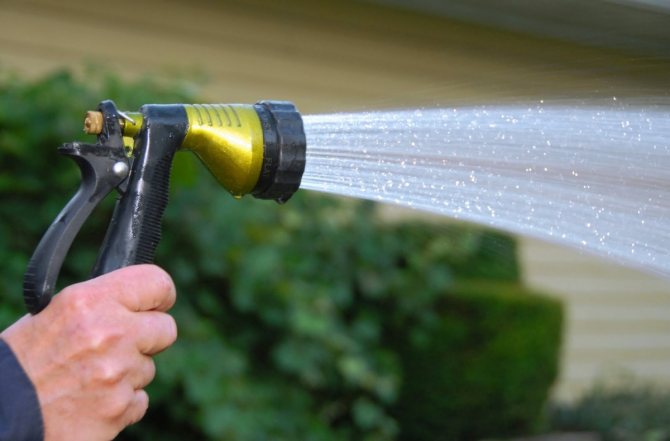

How to plant thuja in open ground in autumn: step by step instructions
To understand how to properly plant thuja in open ground in the fall, the following step-by-step planting instructions, as well as a description of all the preparatory processes, will help.
How to choose a good thuja seedling for autumn planting
Advice! It is best to choose a thuja seedling in nurseries, garden centers or specialty stores. At the same time, they must have a good reputation, positive reviews from real buyers.
Firstly, they usually sell quality goods there. Secondly, if you have any questions regarding the planting material (variety, age, planting characteristics and cultivation techniques), you can ask the seller.
Today on sale you can find 2 types of thuja seedlings:
- With a closed root system (ZKS). In this case, the seedling is in the ground, and the earthen lump, in turn, is in a container (a pot or some other container), therefore it is often called "container type". It is better to buy and plant just such a seedling: firstly, it is easier to plant, secondly, the chances of successful survival are much higher, and thirdly, it can be planted in spring, summer, and autumn. However, it also costs more.
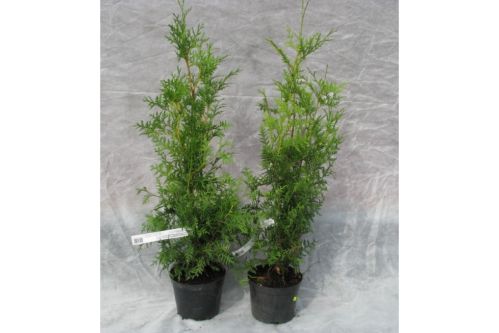

Important! You can remove the earthen lump with the seedling from the container only immediately before planting: you cannot leave the earthen lump in the open air for more than 10 minutes. Otherwise, the roots will immediately begin to dry out, and this will negatively affect the condition, health and vitality of the seedling.
- With an open root system (OCS). The name speaks for itself: the roots of the planting material are open, they are sold without an earthen coma (for example, in a package). It is cheaper than the first option, but it is more troublesome when planting, and you also need to take care of its storage if you bought it ahead of the planned landing.
Garden centers and nurseries mainly sell seedlings with a closed root system (in a container). It is rare to find a specimen with an OKS.
Before you go shopping, you should know the rules that will help you choose high-quality thuja fathoms for autumn planting:
- First of all, it is necessary to assess the general condition of the seedling: it must be healthy, have no signs of damage to the bark, shoots, needles, diseases, pests.
- Be sure to check with the seller the age of the seedling, it is best to plant planting material that is 3-4 years old (it will take root better and faster).
- It is recommended to choose a planting material that has a symmetrical shape.
- A good adult should have a lush crown.
- A thuja seedling should have a healthy, developed root system:
- In a seedling with an open root system (ACS), the roots should be elastic, without damage, not dry, there should be no signs of rotting, mold (even just a moldy smell should alert you!).
- To check the root system of a seedling with a closed root system (CCS), you should inspect the bottom of the container: the roots should not stick out much from the drainage holes (this indicates that the seedling has been in this pot for a very long time). Also, if possible, carefully remove the earthen lump of the seedling from the container. The roots should have a white-pink color, but the brown roots should alert you.
Diseases and pests
Thuja pests are:
- motley moth, leading to the death of the tops of the shoots;
- false shield (affects young processes);
- click beetle (damages the root system).
For pest control, pyrethroids, karbofos, actellic are used. Spraying with solutions of these drugs is carried out.
Tuyu can be amazed by:
- phytophthora, which destroys the root of the plant, which makes it wither and the trunk becomes soft;
- brown shoots (some scales turn yellow);
- fusarium.
You can prevent the development of these diseases with the help of fungicides. Fundazol is used to combat fusarium.
Thuja is a plant that requires proper care and maintenance. Correct pruning of the plant allows you to form a beautiful decorative crown and make the garden unique.

